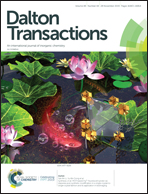Reactions of In–Zn bonds with organic azides: products that result from hetero- and homo-bimetallic behaviour†
Abstract
The indyl anion, K[In(NONDipp)] (NONDipp = [O(SiMe2NDipp)2]2−, Dipp = 2,6-iPr2C6H3) reacts with group 12 compounds M(BDIR)Cl (M = Zn, Cd; BDI = [HC{C(Me)NR}2]−, R = 2,4,6-Me3C6H2 (Mes), Dipp) to afford the heterobimetallic compounds (NONDipp)In–M(BDIR) that contain the first In–Zn and In–Cd bonds. The reactivity of the In–Zn bonds towards organic azides, R′N3 (R′ = Mes, Dipp, Ph) was investigated. (NONDipp)In–Zn(BDIMes) reduces MesN3via an isolable triazenide intermediate to generate the bridging imido compound, (NONDipp)In–(μ-NMes)–Zn(BDIMes). Similar reactivity is noted from early–late heterobimetallic complexes. Under the same conditions, PhN3 reacts to afford a product that contains a bridging tetraazenide ligand, which is formed from the formal (2 + 3)-cycloaddition of second azide to an indium-imido bond. However, increasing the bulk of the BDI-ligand in (NONDipp)In–Zn(BDIDipp) leads to reductive coupling of PhN3 to give the hexazene complex. This mode of reactivity is reminiscent of the reductive behaviour of homobimetallic compounds.



 Please wait while we load your content...
Please wait while we load your content...